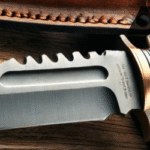The Bowie knife is an iconic blade renowned for its versatility, strength, and distinctive design. Originating in the early 19th century, it remains one of the most popular knife styles among hunters, survivalists, and collectors. In this comprehensive article, we explore the key design elements, materials, and features that make the Bowie knife an exceptional tool for various applications.
The Bowie knife was popularized by James Bowie, a legendary American frontiersman and fighter. The original design is attributed to blacksmith James Black, who forged the first versions of this knife in the 1830s. Over time, the design evolved into the modern Bowie knife, characterized by its clip-point blade, crossguard, and long cutting edge.
Key Design Features of the Bowie Knife
1. Blade Shape and Size
One of the most defining aspects of a Bowie knife is its clip-point blade. This feature enhances precision, making it ideal for piercing and cutting. The blade length typically ranges between 6 to 12 inches, providing a balance between reach and maneuverability.
2. Clip Point and False Edge
The clip-point tip is a hallmark of the Bowie knife. It features a concave or straight cut on the back of the blade, reducing weight while enhancing its ability to pierce effectively. Many Bowie knives also have a false edge, which can be sharpened for additional functionality.
3. Full Tang Construction
A high-quality Bowie knife typically boasts a full tang design, meaning the blade extends through the handle. This construction improves strength, balance, and durability, making the knife capable of withstanding extreme use.
4. Guard and Handle Design
Bowie knives feature a crossguard to protect the user’s hand from slipping onto the blade during use. The handle is usually made of wood, bone, micarta, or synthetic materials, ensuring a firm grip and ergonomic comfort.
5. Blade Materials
The effectiveness of a Bowie knife greatly depends on its blade material. Some of the most common materials used include:
- High Carbon Steel – Offers exceptional sharpness and edge retention but requires regular maintenance to prevent rust.
- Stainless Steel – More resistant to corrosion and easy to maintain, though it may not hold an edge as long as carbon steel.
- Damascus Steel – Known for its distinctive wavy pattern and superior strength, making it a preferred choice for premium Bowie knives.
Functionality and Uses of the Bowie Knife
1. Hunting and Skinning
The Bowie knife is widely used for hunting applications. Its long, sharp blade allows for efficient skinning and butchering of game. The clip-point design also enables precision cutting when handling animal hides.
2. Survival and Bushcraft
A Bowie knife is a must-have tool for outdoor enthusiasts and survivalists. It can be used for batoning wood, cutting rope, and crafting shelter, making it an indispensable companion for wilderness survival.
3. Combat and Self-Defense
Historically, the Bowie knife was used as a combat weapon. Its razor-sharp edge and balanced weight make it highly effective in close-quarters combat, self-defense, and tactical applications.
4. General Utility and Everyday Carry (EDC)
Although large Bowie knives are not practical for EDC, smaller versions serve well as utility knives for camping, fishing, and everyday cutting tasks.
Types of Bowie Knives
1. Traditional Bowie Knife
The classic best Bowie knife features a clip-point blade, brass guard, and wooden handle. This traditional design remains a favorite among collectors, historians, and outdoor enthusiasts. The brass guard enhances grip security, preventing accidental slips, while the wooden handle, often made from hardwoods like walnut or rosewood, provides both durability and a comfortable grip. The traditional Bowie knife is well-balanced and highly functional for tasks such as hunting, skinning, and general utility work. It is also revered for its historical significance, often being seen as a collector’s piece.
2. Modern Tactical Bowie Knife
Designed for military and tactical use, modern Bowie knives incorporate several advanced features that make them more suited for rigorous applications. These include:
- Serrated Edges – Useful for cutting through tough materials like rope, fabric, and even light metal.
- Synthetic Grips – Made from materials like G-10, rubber, or polymer for enhanced grip and durability in extreme weather conditions.
- Coated Blades – Often coated with black oxide or titanium nitride to improve corrosion resistance and reduce light reflection for tactical stealth.
Modern tactical Bowie knives are designed to handle intense fieldwork, survival scenarios, and self-defense. They often feature reinforced spines and a more aggressive point for improved penetration and combat effectiveness.
3. Custom and Handmade Bowie Knives
Many skilled knife makers craft custom Bowie knives, offering a unique blend of artistry and performance. These knives often incorporate:
- Damascus Steel Blades – Known for their intricate wave patterns and exceptional sharpness.
- Personalized Handles – Made from premium materials such as stag horn, exotic hardwoods, or even fossilized ivory.
- Intricate Engravings – Custom Bowie knives frequently feature hand-engraved designs and inlaid gemstones to enhance their aesthetic appeal.
These knives are highly sought after by collectors, hunters, and enthusiasts who appreciate both the craftsmanship and functionality of a well-made blade. Whether for display, heirloom collection, or practical use, a custom Bowie knife offers unparalleled quality and uniqueness.
Choosing the Right Bowie Knife
When selecting a Bowie knife, consider the following factors:
- Intended Use – Choose a model that suits your needs, whether for hunting, survival, or self-defense.
- Blade Material – Opt for a material that balances edge retention, durability, and ease of maintenance.
- Handle Comfort – Ensure the handle provides a secure grip, reducing hand fatigue during extended use.
- Blade Length – Shorter blades (6-8 inches) offer more control, while longer blades (10-12 inches) provide extended reach.
Maintenance and Care Tips
To prolong the lifespan of your Bowie knife, follow these essential maintenance steps:
- Clean the Blade Regularly – Wipe the blade after use and apply a light coat of oil to prevent rust.
- Sharpen the Edge – Use a whetstone or sharpening system to maintain a razor-sharp cutting edge.
- Store Properly – Keep the knife in a sheath or dry storage case to protect it from moisture and dust.
- Avoid Excessive Moisture – If your knife has a carbon steel blade, ensure it remains dry to prevent corrosion.
Conclusion
The Bowie knife stands as a symbol of craftsmanship, utility, and historical significance. Its versatile design and durability make it a valuable tool for hunters, survivalists, and collectors alike. Whether used for hunting, self-defense, or outdoor survival, a well-crafted Bowie knife remains an indispensable asset.




